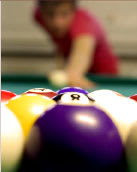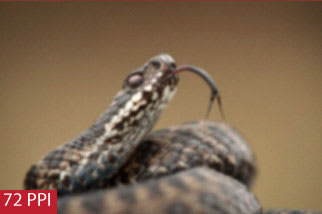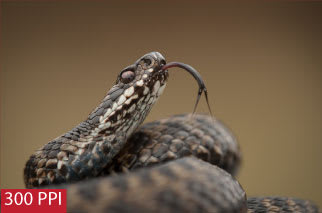Image Quality of Your Artwork Is Too Low

Proper epitome resolution is critical to printing a professional slice that features crisp graphics, abrupt definition and beautiful color depth. It's important to bank check your image resolution before you print to ensure your projection looks as amazing on paper equally it does on your estimator screen.
Our guide to image resolution includes:
- What is epitome resolution?
- What is the best resolution for press?
- How to bank check image resolution
- How to fix image resolution bug
Whether you're printing marketing tools such every bit business cards, brochures, and postcards or keepsakes such as family photos, refrigerator magnets, or greeting cards, y'all tin print picture-perfect artwork with these tips for proper image resolution.
What is epitome resolution?
Epitome resolution tin be defined every bit the level of detail in an image. Raster images are comprised of a series of pixels, where resolution is the]]> total number of pixels forth an prototype's width and pinnacle]]>, expressed as pixels per inch (PPI).
The greater the PPI, the greater the particular and the better the impress quality – whether you're printing invitation cards for an upcoming event or a family unit photo to frame on your wall.

Ofttimes, PPI and dots per inch (DPI) are used interchangeably; nevertheless, PPI and DPI are non identical. Though they are like, PPI refers to the pixels per inch on your computer screen, while DPI refers to the ink dots per inch applied by a press press.
If your press visitor requires artwork in a certain DPI, chances are they're really referring to PPI. Again, the easiest way to think about it is:
- Pixels per inch (PPI) refers to image resolution on your calculator screen
- Dots per inch (DPI) refers to image resolution on printed paper

You don't need to worry about resolution when you design your ain brochures, postcards, business cards, greeting cards, stickers, and more with our free design templates and online design tool!
Make your own design online
Note: Resolution applies to raster images, which are comprised of pixels, just not vector images, which employ mathematical calculations to produce images. Learn more about the difference betwixt raster and vector images.
What is the all-time resolution for printing?
What resolution should photos be for press? What should DPI (or PPI) exist for press high-quality artwork? In many cases, the all-time resolution for printing is 300 PPI.
At 300 pixels per inch (which roughly translates to 300 DPI, or dots per inch, on a printing press), an prototype will appear sharp and well-baked. These are considered to be high resolution, or loftier-res, images. (If you're working with photography, y'all're probably working with high-resolution JPEGs, which tin be printed every bit stand-solitary photos or incorporated into your brochure printing and other projects).
What about the all-time resolution for pictures online? Web images are commonly created in 72 or 96 PPI, which are considered to exist low resolutions. They're perfect for the spider web considering they feature smaller file sizes that can load quickly online, only they exercise not translate well to print.
Low resolution, or low-res, images will announced pixelated and blurred after press – even though they might look perfect on your computer screen. That's because in that location aren't enough pixels per inch to maintain a sharp epitome at large document dimensions.
- Document dimension: The physical size of the printed piece. Example: four" x half-dozen" postcard
- Resolution: Pixels per inch (PPI)

Information technology'southward important to understand the relationship between document dimension and resolution.
For instance, a iv" x 6" epitome at 72 pixels per inch would have a total pixel dimension of 288px (superlative) by 432px (width). That means there would but exist 288 pixels spread out over four inches. To brand that stretch, each of those 288 pixels would need to be rather large, resulting in a blurry, pixelated image.
A iv" x 6" image at 300 pixels per inch (a common size for postcard printing), on the other mitt, would have a total pixel dimension of 1,200px (elevation) by 1,800px (width). Compared to the 72 PPI version, the four-inch bridge would exist represented by 1,200 pixels instead of 288 pixels – or 912 more pixels. That means the pixels can exist smaller, resulting in higher definition and articulate, sharp image.

The best resolution for a given project depends on multiple factors, including the blazon of project you're printing and the type of printer you're using. For example, if you want to impress high-quality business flyers on an get-go or digital printing press, your flyers should exist 300 PPI. If you want to print 8" x ten" photos on your inkjet printer, a resolution of 220 PPI might be enough to produce adequate results.
| Project | Printer | Resolution |
|---|---|---|
| Marketing tools (brochures, business cards, flyers, posters, etc.) | Offset or digital printing press | 300 PPI |
| Photos (4 x vi, five x 7, 8 x ten) | Kickoff or digital printing press | 300 PPI |
| Photos (iv ten 6, 5 x vii, viii x 10) | Desktop inkjet printer | 220 PPI |
| Print on need garments and accessories (T-shirts, mugs, hats, etc.) | Large format inkjet printer | 150 to 300 PPI |
| Screen printed garments (hats, shirts, etc.) | Screen printer | 150 to 300 PPI |
Those are examples; every printing company has its own resolution requirements. The best pixel size for impress can vary between printing companies, press formats and printing presses. Information technology's best to bank check with your printing company earlier y'all create your artwork then you lot tin can format it in the proper resolution.
The size of your final printed projection tin can determine whether you can impress in a lower resolution; for case, a 150 PPI image might await fine at 4" x six" just look blurry at 8" ten 12". Often, information technology'south best to err on the side of caution and create your artwork in 300 PPI, since you tin downsize if needed without sacrificing quality.

You might wonder how resolution relates to cameras, specially if yous're taking pictures with an iPhone or other smartphone. The higher the resolution of your camera, the larger you can impress images and still get a clear output.
How many pixels are in 300 PPI depends on the document dimensions. Allow's say, for example, y'all want to impress an eight" ten 10" photo at 300 PPI (the best resolution for a photo, in most cases).
You can multiply both 8 and 10 by 300 to get the full pixel dimensions of the finished image.
- 8(300) X 10(300) = 2,400px X iii,000px
You tin can multiply both 8 and 10 by 300 to become the full pixel dimensions of the finished image.
- 2,400 X three,000 = vii.two million pixels
Another name for vii.2 meg pixels is 7.two megapixels (MP); which ways yous'll need a minimum 7.2 MP photographic camera to get the best resolution for your viii" x 10" photo.
Fortunately, the latest-model iPhones characteristic camera resolutions upward to 12 MP; and DSLR cameras often feature eighteen MP and upwards, so you don't need to be a professional photographer to start with a high-resolution epitome.
You tin utilise this knowledge to effigy out other questions, such as "how large is 1920 x 1080 in inches?" All you need to know how to convert pixels to inches.
If you know the PPI – again, let's say 300 – you divide the full dimensional pixels to decide the inches:
- 1920/300 = half-dozen.four
- 1080/300 = 3.6
So, a 1920x1080 image in 300 PPI would be 6.4" ten three.6"
For another instance, nosotros might want to effigy out how many pixels are in a 5 x 7 image. Again, nosotros need to know the PPI.
If information technology's 300 PPI, you lot would multiply that figure past 5 and seven, respectively:
- five(300) = one,500
- 7(300) = two,100
So a 5 10 7 image at 300 PPI would be 1,500px by two,100px.
Now, you can effigy out the total megapixels by multiplying width times pinnacle:
- 1,500(two,100) = 3.fifteen meg pixels, or 3.xv megapixels
In this case, you tin can print a high-quality 5 x vii photo past snapping a picture with a 3.ii MP (or greater) camera.
Take the guesswork out of file grooming with free layout templates for brochures, postcards, business cards, greeting cards, stickers and more than!
Download free layout templates
How to check your image resolution
How do you find the resolution of an image? How can you tell if an image is high resolution? Here are five like shooting fish in a barrel ways to make up one's mind the resolution of any image. Apply them to check files for proper resolution before press.
1.How to check paradigm resolution with Adobe Photoshop
- Open your paradigm in Photoshop
- on Image > Image Size
- View the resolution section
If the resolution is already set at 300 PPI, your artwork is print-ready.

ii.How to check image resolution with Adobe Acrobat
- Open your file in Acrobat
- Set the view to 300%
If your artwork appears pixelated, it'southward low resolution. If it appears crisp at 300 percent, then your artwork is print-ready.

3.How to check image resolution with Windows
- Open Windows Explorer and browse to the folder that contains your image
- Right-click on the image file and select "Backdrop"
- Click on the details tab
Your paradigm resolution volition display in the details tab.

4.How to check image resolution on a Mac
- Scan to the folder that contains your image
- Right-click on the image file and click "Get Info"
- Click on the "More than Info" tab
Your prototype resolution will display in the More Info tab.
5.Check image quality online
Search online for a photo quality checking tool. One example is the ]]>Ghiro Digital Image Forensic Analyzer]]>. You can upload your photograph and select the EXIF tab to run into your photo resolution. It's an piece of cake way to check the resolution of a JPEG epitome before y'all begin editing.

How to fix paradigm resolution bug
The best style to fix image resolution issues is to start with a high-res image that's at least 300 PPI; however, that's non always possible. Finding your image resolution is uncomplicated, and if it's already set up in the proper resolution you're adept to go.
But what if your resolution is likewise low for high-quality printing? How practise y'all make a low-resolution photograph loftier resolution? Do you need to change the size of a JPEG, or make a high resolution JPEG?
Resolution isn't the but thing that dictates quality. Bring your artwork to life with brilliant soy-based inks and state-of-the-art digital and commencement printing services at discount prices.
Print premium products at present
ane.How to increase image resolution in Photoshop (and reduce image size)
If the original image has large document dimensions (bodily printed size) still low resolution, you can increment the resolution without sacrificing much quality – nevertheless, your document dimensions volition decrease significantly.
Let'southward say y'all have a JPEG file that has a document size of viii" x x" merely a resolution of 72 PPI. How do you make a JPEG higher resolution or brand a picture 300 DPI? You can use Photoshop to change the resolution to 300 PPI.
- Click Paradigm > Paradigm Size
- Uncheck the "Resample" box
- Prepare the resolution to 300 PPI and click "OK"

Your image volition at present exist set to 300 PPI without significant loss of quality; nonetheless, it volition have changed dimensional size – in this example, from viii" x ten" to 1.92" x 2.4". That'southward pretty small, but if you're designing a brochure it might exist big enough, dimensionally, for an prototype set in the text.


ii.How to increase image resolution in Photoshop (and maintain prototype size)
If you want to increment image resolution yet maintain document dimensions, you would follow the same process as above – except this time, you'll make sure the "resample" box is checked:
- Click Image > Image Size
- Bank check the "Resample" box
- Set the resolution to 300 PPI and click "OK"

In this case, Photoshop will attempt to add together new pixels between existing pixels to increase the resolution and maintain dimensional size. It does this past analyzing individual pixels and automatically calculating what should go between them. For instance, if a blueish pixel is next to a red pixel, it might add a regal pixel between them.
- Automated
- Photoshop automatically decides which choice is best based on the type of certificate you accept and whether yous're scaling the size up or down.
- Preserve Details (enlargement)
- Adds a racket reduction slider so you can shine the paradigm when you lot enlarge it.
- Bicubic Smoother (enlargement)
- Enlarges your image with an automatic emphasis on smoothness.
- Bicubic Sharper (reduction)
- Used to reduce image size while maintaining sharpness.
- Bicubic (smoother gradients)
- A procedure for enlarging or reducing that produces smooth tonal gradations.
- Nearest Neighbor (hard edges)
- Replicates image pixels merely is less precise than other methods.
- Bilinear
- Adds pixels co-ordinate to the average color values of surrounding pixels.southward
You lot can play around with each of these options to see which produces the all-time results for your image. However, resampling ofttimes leads to undesirable effects such as poor image quality. Many experts recommend resampling by only v to 10 percent to minimize image distortion.
Yous can try to regain lost detail with Photoshop'southward Unsharp Mask filter, though results might be mixed.
Unfortunately, resampling in this manner frequently leads to undesirable effects. Many experts recommend resampling by merely 5 to x percent to minimize image distortion. Learn more than near print layout guidelines for Photoshop.


three.Professional person photo enlarging
If you're unable to attain a high-quality, high-resolution photograph on your own, professional photo enlargers can help. Instead of using automated processes, they use software to manually manipulate your photos to increase resolution and even document dimension, if required.
Even if y'all're pretty savvy in Photoshop, yous might want to consult a professional photo enlarging service if you're printing large-format graphics; for example, wall graphic press.

four.Online picture resizer
You tin as well consider using an online film resizer to change the size of images. These tools tin be used to check image quality online.
Results might be mixed, depending on the original resolution of your prototype and your desired output. If your original image is likewise pocket-size, no epitome resolution converter can maintain quality when yous increase resolution.

Again, the best choice is to start with an epitome that'southward already as large – or larger – than you need it, both past document dimension and resolution. If that's non possible, y'all tin can try the options listed here to increment your prototype resolution without losing quality. Learn more with this gratuitous print quality checklist.
Once your image is sized and in the proper resolution, you tin add together information technology to your artwork and transport it to print, confident it will look equally incredible on paper equally it does on your computer screen. Bring your artwork to life with premium press services at disbelieve prices today!
Source: https://www.psprint.com/resources/how-to-check-your-image-resolution/
0 Response to "Image Quality of Your Artwork Is Too Low"
Post a Comment